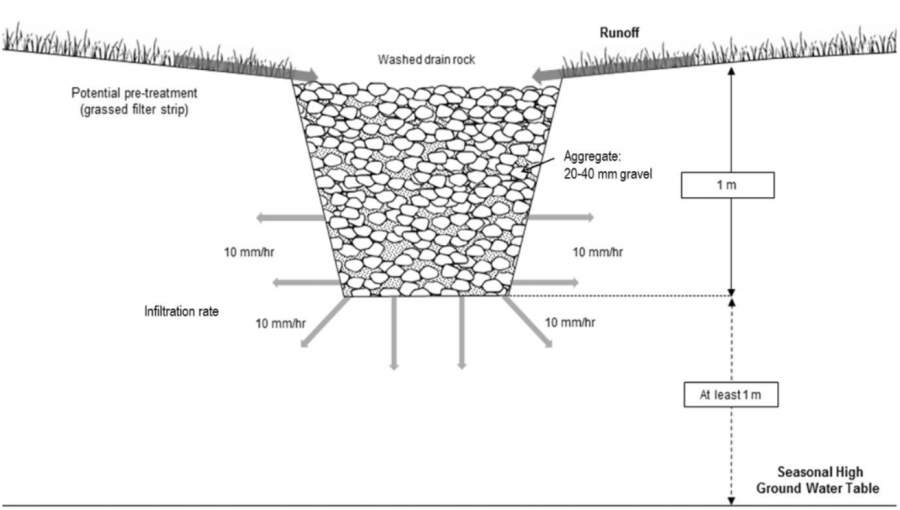Field investigations must be undertaken to determine the soil type; hydraulic conductivity; presence of soil salinity, rock and other geological limitations; slope of the terrain; and groundwater level, depth and quality.
Infiltration should be avoided in the following soil types and contexts:
- saline, sodic or very shallow soils
- wind-blown or loose sands
- clay soils that collapse in contact with water or have high shrink/swell characteristics
- soils with a hydraulic conductivity of less than 0.36 mm/hr
- steep terrain (generally slopes >5% )
- if maximum seasonal ground water level is within 1m of the proposed base of the infiltration trench, pit or chamber
- fill material
- contaminated soils.

Schematic of a gravel trench
Source: City of Auckland (2017) Stormwater management devices in the Auckland Region: Guideline document 2017/001 Version 1. Pg 234, Fig. 47.
Tip 2 – Minimum setback distances from building footings (and property boundaries)
Infiltration characteristics of common soil types and set back distances from building footings and property boundaries

Adapted from Australian Runoff Quality, Engineers Australia 2006
1 Melbourne Water (2005). WSUD Engineering Procedures: Stormwater. CSIRO Publishing.
2 Wong T (2006) Australian runoff quality: Guide to water sensitive urban design. Engineers Australia.
Tip 3 – Pre-treatment of stormwater is essential to prolong asset life
Pre-treatment methods to minimise sediments from entering the infiltration system include: a swale, grassed bugger strip, sumps (preferably with hung baffles), or filters.
Infiltration devices: Managing silt – bottomless SEP (1:39) | Tim Johnson
Infiltration devices: Managing silt – agricultural pipe in SEP (4:03) | Tim Johnson
Tip 4 – How to size your infiltration system
Size the device area to allow for complete infiltration within 72 hours.
Details for engineers for sizing an infiltration pit can be found in:
- Lot scale <1000m2 – Look up table Plan SA (2020) Ministerial Building Standard (MBS) 009, On-site stormwater retention
- All scales Argue J (2013) WSUD: Basic procedures for ‘source control’ of stormwater – a handbook for Australian practice, Student edition. University of South Australia
- All scales Wong T (2006) Australian runoff quality: Guide to water sensitive urban design. Engineers Australia.
Tip 5 – Construction – roughen sides of infiltration trench with a backhoe or excavator bucket with teeth
Tip 6 – Use of underdrains, overflows and observation wells
- If used for detention purposes, the storage capacity should be designed to accommodate for the required design storm.
- Underdrains are required where permeability of surrounding soils is too low to fully infiltrate the design storm.
- Infiltration systems should be fitted with an overflow system in case a storm event exceeds the infiltration and storage capacity.
- An observation well should be installed so that future inspections can determine whether the device is functioning as designed.
Tip 7 – Aggregate specifications
Typically, aggregate should consist of clean (fines free) drainage aggregate of 20-40mm diameter, with a defined void ratio of 0.3.
Tip 8 – Use of geotextile
Geotextile must be secured at edges and base, and all joins overlapped to prevent the movement of fine sediment between the infiltration device layer and base soils, and provide required tensile strength.





